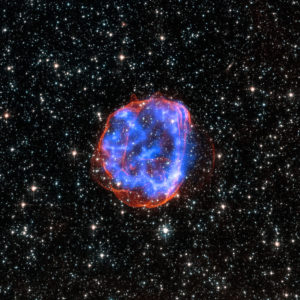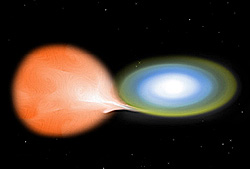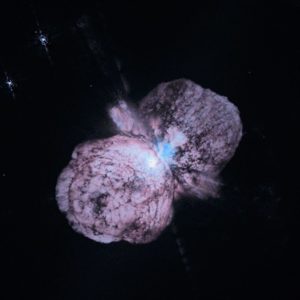
Supernova remnant
Novae and supernovae are among the most energetic phenomena encountered in the galaxy. Planetarium educators can simulate a number of historical nova and supernova events on SciDome using Starry Night Dome Version 7.
The following 10 transient objects can be investigated in Starry Night 7’s “Historical Supernovae” database on’s :
- SN 1987A (Progenitor: Sanduleak -69° 202)
- Supernova 1680 (Cassiopeia A)
- SN 1604 (Kepler’s Star)
- SN 1572 (Tycho’s Star)
- SN 1181
- SN 1054 (Crab Nebula)
- SN 1006
- SN 393 (G347.3-0.5)
- SN 386 (G11.2-0.3)
- SN 185 (RCW 86)
Each of these supernova simulations behave in one of two ways on the dome.
The supernovae of the years 1987, 1604, 1572, 1181, 1054 and 1006 in the Common Era were all relatively well-studied when they were visible, and their positions have been correlated with current supernova remnants. These objects are best treated in SciDome: if you look at the sky on the date they appeared and in the correct position, toggling backward and forward several days, the “Guest Star” phenomenon makes the supernova pop into existence, flare up slightly, and then fade away over the course of several months.
The supernovae of the years 1680, 393, 386 and 185 were not well-observed at the time we estimate they exploded due to interstellar dust blocking their light, the difficulty of keeping reliable extremely old observing records, etc. However, some unconfirmed observing reports claim they were observed, and their positions correlate well with supernova remnants or pulsars detected with X-ray telescopes. With no firm dates or estimated brightnesses, it’s appropriate that their positions should be marked, but these four objects do not flare up and then dim out like the first six. There are also photos of the supernova remnants docked in position over these transients in Starry Night.
How about adding objects to this database manually? That’s not so hard, and there are several candidates that have similarities to historical supernovae (although the above ten are the only recorded historical supernovae that have been as bright as the brightest stars).

Artist’s conception of a white dwarf accreting hydrogen from a larger companion
If a supernova is a star that explodes completely, a nova is a star that is only partly exploding. There are a few different theories to describe the processes in a nova star. The most common is that a white dwarf star and a normal star are orbiting each other, and the normal star is close enough to deposit some outflowing gas on to the surface of the white dwarf. The gas builds up on the surface of the white dwarf star until it becomes unstable and explodes. The white dwarf star survives the explosion. These novae can even re-occur once the gas builds up again.
Today is the 99th anniversary of the appearance of the “Victory Star”, also known as Nova Aquilae 1918 or V603 Aquilae. For several days this star was the brightest nova in the age of the telescope, magnitude -0.5, as bright as the brightest stars. It faded back to obscurity quickly. It was known as the Victory Star because some saw it as a portent of the end of the Great War. Also, in an extreme coincidence, it appeared on the same day in June 1918 as a total eclipse of the Sun was seen from coast to coast across the United States.
The file that encodes the Historical Supernovae database is in the Sky Data folder for Starry Night 7 on both Preflight and Renderbox. This feature is not available in Starry Night 6. To make a change, both files need to be edited in an identical fashion.
Here is the code that can simulate the Nova 1918 star by pasting into a new “11th” paragraph:
<SN_VALUE name="00011_Mag_Field_BackGround" value="6.00000000000000e+0, 1.04124631531834e+1, 1.00000000000000e+0"> <SN_VALUE name="00011_Name" value="Victory Star 1918"> <SN_VALUE name="00011_ObjectSource" value="V603 Aquilae"> <SN_VALUE name="00011_ObjectType" value="Supernova Remnant"> <SN_VALUE name="00011_RA_Dec_DistanceLY" value="2.82229166667e+2, 0.058412861111e+1, 8.10000000000000e+2"> <SN_VALUE name="00011_Width_Height_PositionAngle" value="4.33363094776427e+0, 4.33363094776433e+0, 3.60000000000000e+2"> <SN_VALUE name="00011_VarMagStartJulian_VarMagPeakJulian" value="2421752.5,2421752.5,0.0"> <SN_VALUE name="00011_VarMagChangeJulian_VarMagEndJulian" value="2421753.5,2422000,5, 0.0"> <SN_VALUE name="00011_VarMagBefore_VarMagAfter" value="11.0, 11.0, 0.0"> <SN_VALUE name="00011_VarMagPreChangeFitParams_1" value="-1,-1.9936204147E-4,6.9776714514E-4"> <SN_VALUE name="00011_VarMagPostChangeFitParams_1" value="-1.988359647,2.9499496875E-1,-1.6722461742E-3"> <SN_VALUE name="00011_VarMagPostChangeFitParams_2" value="3.9382638857E-6,-3.2343556849E-9,0.0">
The subsequent data line with the tag “Layer_NumberOfObjects” still has the value=”10″, and this value needs to be updated accordingly to 11.
Alternately, you can download an edited copy of the file, unzip it, and install it. If you feel you need a little guidance in installing it, please contact Spitz Support.
The Right Ascension and Declination (RA and Dec) co-ordinates of the new star have to be entered in decimal hours and decimal degrees. The values in the line with the tag “00011_RA_Dec_DistanceLY” are accurate to put the nova in western Aquila several degrees above the asterism of stars that makes up the “foot” of the Eagle.
Some of the above values are just copied from an earlier part of the file, but the observing period, expressed in Julian dates, is shorter than for a supernova. There are only 248 days between the date 2421752 (representing June 8, 1918) and 2422000 when we can estimate the new star had dimmed below the threshold of visibility.

The Homunculus Nebula, surrounding Eta Carinae
There are several other nova stars that can be shoe-horned into this database. For example, the extremely massive star Eta Carinae is currently quite dim and surrounded by an emission nebula, but it is studied so well now because for many years in the mid-19th century its brightness fluctuated wildly up and down, and for some time it was the 2nd-brightest star in the sky.
If future predictions are just an extension of history, perhaps we can use SciDome to get ahead of a possible nova that could flare up in about five years from now. KIC 9832227 is a contact binary star in Cygnus, like the one on the cover of Dr. Bradstreet’s Spitz Fulldome Curriculum Volume 2, and a prediction was made in January of this year that at some time in about 2021 or 2022 the two stars will coalesce together and outburst in brightness. Because the two stars are whirling around each other every 11 hours, due to uncertain mixing and modeling, the error bars make it difficult to accurately predict this “future historic nova”, but it could happen, and we can even try and get the drop on it.
